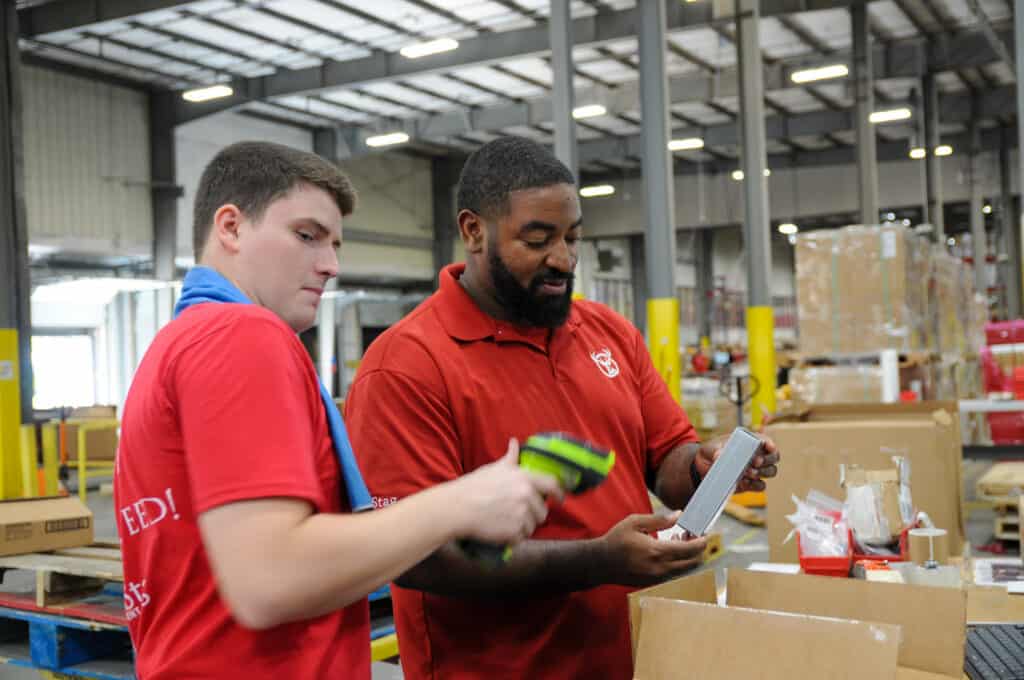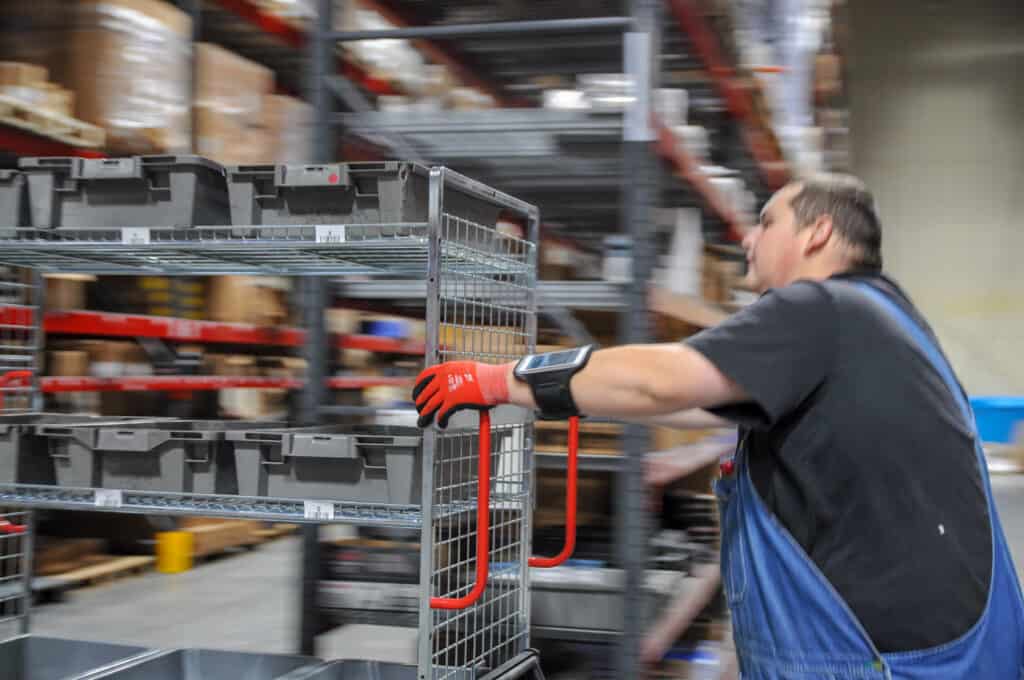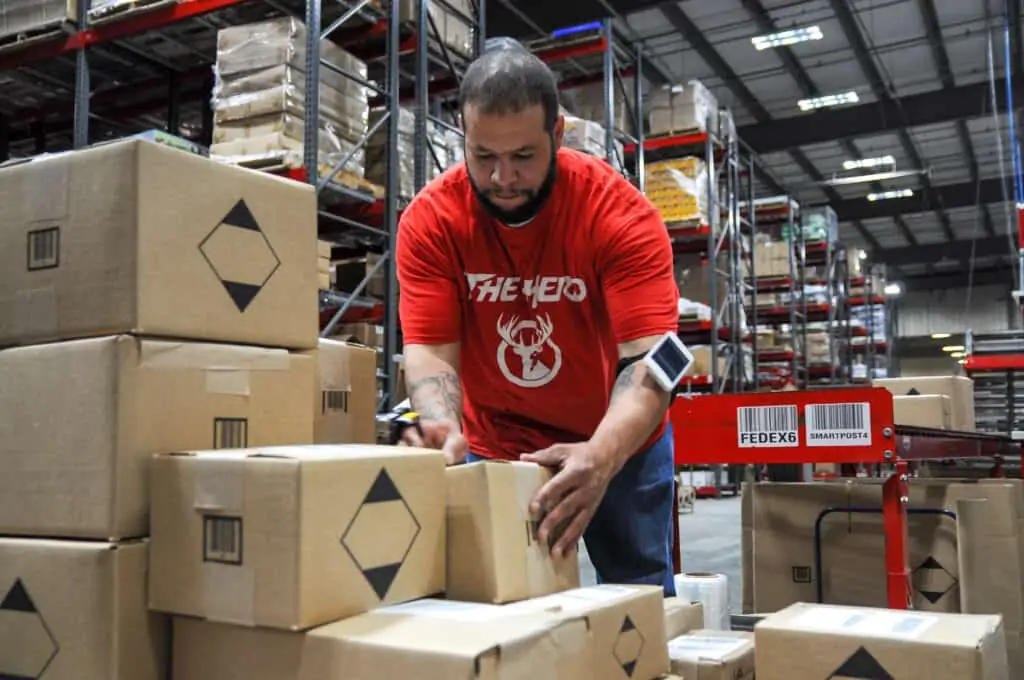Kitting logistics is an ecommerce fulfillment process for pre-assembling individual items into kits to make fulfillment faster and easier. Warehouse kitting is a service that some 3PLs offer.
However, many ecommerce entrepreneurs don’t know they can take advantage of it. Here’s your guide to the kitting process, how it can fit into your fulfillment strategy, and why it will increase your customer satisfaction.
TL;DR:
Kitting benefits and applications

Kitting pre-assembles individual items into ready-to-ship packages for faster, more accurate fulfillment.

Benefits include reduced errors, faster order fulfillment, lower packaging costs, and better inventory flexibility.

Ideal for subscription boxes, heavy/bulky items, seasonal gift sets, and products commonly ordered together.

The process happens before orders come in, creating new SKUs that simplify the pick and pack process.
What is kitting logistics?
Kitting logistics is the process of assembling two or more products into a kit to send to a customer. The kitting process happens before order fulfillment, so kits are ready when orders come in.
Kitting makes fulfillment more efficient because 3PLs can pick and pack orders quickly. It also reduces fulfillment errors, thus increasing your 5-star reviews.
DEFINITION: Kitting is a pre-assembly process that combines multiple individual items into a single SKU, creating ready-to-ship packages that streamline fulfillment operations and enhance customer experience.

When does kitting happen in the order fulfillment process?
Fulfillment kitting starts before any orders come in. First, you select the products you want to sell as a kit and create an SOP for the kitting process. For example, you might wish to pack your kit in a particular order to give your customers a delightful unboxing experience. The kitting process also takes into account the best way to pack multiple items together so they arrive in perfect condition.
Once you have developed a kitting SOP with your 3PL team, the kitting process can begin. The kits will get a new SKU and warehouse location. The warehouse kitter will gather the items for the kits at a kitting station in a section of the warehouse away from pick and pack fulfillment operations. The kitter can quickly assemble your kits without the pressure of orders to fill.

Advantages of warehouse kitting
Customers love sets because they make it easier and simpler to give gifts, they often involve discounted pricing, and they are fun to unpack. You’ll love kitting fulfillment, too, because it is an efficient order fulfillment strategy. Here are just a few ways that warehouse kitting can help you grow and scale your ecommerce store.
Create an efficient assembly process
01
It will take some time for a picker to get items for a kit from multiple locations around the warehouse. If you sell the same group of products repeatedly, the kitting assembly process is the preferred way to create kits.
Reduce fulfillment errors
02
The picker running from one end of the warehouse to the other to pull separate items for a kit is under time pressure. They have many orders to fill, and every minute counts. That’s the ideal setup for human error. However, when items are pre-kitted, the picker only has to make one stop to gather the full kit.
Keeping your fulfillment error rate close to zero is crucial for growing your business. After all, it only takes a few unhappy customers who got the wrong thing or were a product short to write negative reviews that hurt your sales.

Add speed to your order fulfillment
03
Giving the picker one stop instead of many is an excellent fulfillment strategy to increase speed. The pick list will have a single SKU for the assembled products, and the packer’s work is mostly done — they just need to add a shipping label.
PRO TIP: When measuring fulfillment speed, pre-kitted items can be processed up to 3-5 times faster than individually picked components, significantly reducing your overall fulfillment time and improving same-day shipping rates.
Save on packaging costs
04
When you work with your 3PL to develop a kitting process, you also optimize your packaging. That could mean fitting more items into a smaller box, something the packer might not have time to do on a fast-moving line. Kitting logistics allows you to develop a packing strategy that reduces packing costs while still protecting your products during shipping.
Use flexible SKUs to make the most of your stock
05
A best practice in inventory management is to keep enough stock on hand to prevent SKUs from going out of stock but not so much that you tie up business funds that could be better spent elsewhere. One kitting logistics challenge is that businesses usually don’t know exactly how many kits they’ll sell ahead of time.
For instance, suppose you put chamomile, peppermint, and licorice together to create 100 of a kitted assortment of herbal teas. You might sell 50 of the kits and have an additional 50 orders for just the chamomile. Suppose you don’t have enough chamomile in stock to fill those orders. In that case, the warehouse management system can retain a record of the original product SKUs so your 3PL can take the kits apart and return the herbal teas to their original SKUs. Flexible kitting is a terrific inventory management strategy to help you pivot quickly when demand changes.

Which ecommerce companies benefit from warehouse kitting?
There are many strong use cases for warehouse kitting. Here are some ecommerce companies that lean the most heavily on kitting fulfillment.

Subscription box companies that send regular, curated assortments to customers

Online retailers of heavy or bulky items that need to optimize shipping costs

Holiday or seasonal gift box sellers that offer curated, ready-to-give packages

Businesses that offer volume discounts on bundled products

Any retailer selling items commonly ordered together who wants to improve fulfillment efficiency
Subscription box companies
Subscription boxes are kits, so businesses that send out subscription boxes almost always benefit from warehouse kitting. This includes any company where customers sign up to receive future shipments at regularly scheduled intervals. Examples of subscription boxes include:

Monthly beauty product assortments

Children’s learning sets

Consumable products like razors or toothbrushes
A subscription box business is a great way to lock in future sales, and an engaging and witty unboxing experience can help keep subscribers hooked. The kitting process enables you to make the packaging part of the product.
Online retailers of heavy or bulky items
Oversized products may be subject to dimensional weight pricing, which can significantly increase shipping costs. Kitting can help bring down the total shipping cost for an order by combining lightweight accessories with a large product.
For example, suppose a customer orders a mattress and a sheet set. Shipping the sheet set in the mattress box through kitting won’t add to the cost of shipping. Plus, the customer gets a single package rather than receiving the products individually. Your customer doesn’t have to worry about where the rest of their order is, and you save money on packaging and shipping costs.
NOTE: Specialized 3PLs for heavy and bulky items are well-equipped to handle kitting for oversized products, with warehouse space and staff trained to efficiently assemble and package large item kits while optimizing dimensional weight charges.
Holiday or seasonal gift box sellers
Buying gifts can be stressful under any circumstance. Kitted gift assortments can reduce that stress and increase your revenue, particularly around holidays, and your customers will thank you.
Perhaps an online shopper is struggling to figure out what seeds and tools to get as a Mother’s Day gift. With kitting, the customer can select a single item: a gardener’s gift set that includes gloves, an exciting seed assortment, and a seed-planting tool.
The kit comes beautifully packaged and gift-ready, which is much nicer than simply sending mom a box full of gardening tools without the pretty packaging. Anytime you can assemble a gift kit, it makes gift-giving easier for your customers and increases your average sale. Kits also build loyal customers who will remember how your gift set helped them out of a jam and made the recipient happy.
Businesses that offer volume discounts
Bundling is a form of kitting that groups sets of the same product or similar products together for a volume discount. Bundling is particularly useful for consumable products. For example, if you sell protein powders in three flavors, you could offer bulk packs with six containers of one flavor or two of each variety. You get a larger sale, and your customer gets a price break for ordering a bundle.
Any online retailer, for items commonly ordered together
Of course, any ecommerce business can benefit from kitting. At Red Stag Fulfillment, we have even used a kitting process to help one of our clients fix a manufacturing problem. When the factory sent an order of products that were all missing one component, we had the manufacturer ship the missing element to our warehouse. We set up a kitting station to make the products complete. That was a faster solution for our client, so they didn’t miss any orders.

Red Stag Fulfillment makes kitting logistics easy
Not all 3PLs provide kitting fulfillment services, but at Red Stag Fulfillment, we have seen firsthand how important it is to our clients. Kitting logistics is a core part of our fulfillment operations because we’re committed to providing superior third-party logistics. Check out our 2021 report card, and then tell us how we can help with your kitting logistics.
Key Takeaway: When choosing a 3PL for kitting services, look for one with dedicated kitting stations, flexible inventory management systems, and experience with your product type. The right partner will help you optimize your kitting process to maximize efficiency and customer satisfaction.
Frequently asked questions about kitting logistics
What’s the difference between kitting and bundling?
While both involve combining multiple products, kitting typically refers to assembling different complementary items into a single packaged unit with its own SKU (like a gift basket), while bundling usually means selling multiple units of the same or similar products together at a volume discount (like a 3-pack of t-shirts).
How do you determine which products to kit together?
The best kitting candidates are products frequently purchased together, complementary items that enhance each other’s value, seasonal or themed collections, and products that can be combined to save on dimensional shipping costs. Analyze your sales data to identify common purchase patterns, then test kit options to find what resonates with your customers.








